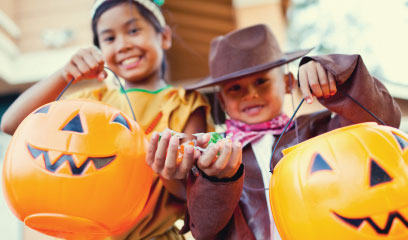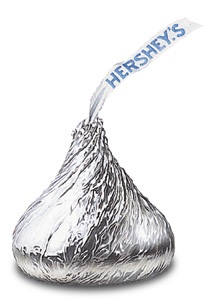 Every Halloween, your children drag home huge bags of candy, and you wonder: How much should I let them eat? What should I do with the rest? And how can I protect their teeth?
Every Halloween, your children drag home huge bags of candy, and you wonder: How much should I let them eat? What should I do with the rest? And how can I protect their teeth?
Joel Berg, Ph.D., chairman of the University of Washington’s Department of Pediatric Dentistry, says kids should only eat candy at mealtimes, because constant snacking supplies cavity-causing bacteria with a steady stream of sugar. Sticky candies — such as caramel — promote tooth decay more than chocolate, which doesn’t stick to teeth. Bellevue family physician Jennifer Richards advises limiting candy, because “less prolonged exposure to candies means less potential for tooth decay and less pressure on the palate toward processed, sweet foods versus more natural choices.” She suggests waiting as long as possible before introducing candy to young children and letting older children choose about 10 favorite pieces of candy to eat during the three days after Halloween. After that, find something else to do with it.
Halloween candy experiments
Candy experiments turn candy into science materials. Encourage children to stretch candy, stick it together, drop it, break it or cut it with butter knives. Test whether hot or cold water dissolves candy faster, see what melts in the oven or test different kinds of candy to see what floats. Even without a scientific goal, young children love putting candy in water, mixing different colors and stirring masses of candy into “candy soup.” You’ll be amazed to discover that the m’s on M&Ms will peel off and float, melted Starbursts gleam with puddles of hydrogenated palm kernel oil, and wet lollipop sticks unwrap into long paper ribbons. For more experiment ideas, see candyexperiments.com.
Candy can teach in other ways, too. Use your senses to learn about the candy. Let your children feel candy through wrappers to see if they can decipher the shapes, patterns and letters underneath. Make a “surprise box” by cutting a hand hole in a shoebox, and let your children feel the candy within to guess what kind it is. Try to identify flavors by tasting or smelling candy blindfolded. Shake candies in a bowl: Do different kinds make different sounds? You can also practice math by graphing the colors in each package or using candy for counters in adding games.
 Candy’s bright colors also make great art. Use your Halloween stash to decorate gingerbread houses, gingerbread trains or a whole gingerbread village. (If you don’t want to fuss with gingerbread and icing, make houses by gluing graham crackers to small milk cartons.) Cut flower shapes out of cardstock, stick on colored hard candy with nontoxic glue, and mount on wooden skewers for a fall bouquet. Make candy mosaics on posterboard or use wrapped candy for collages and storyboards. (If using Elmer’s glue, allow several hours for your creations to dry and display them out of reach of little fingers!)
Candy’s bright colors also make great art. Use your Halloween stash to decorate gingerbread houses, gingerbread trains or a whole gingerbread village. (If you don’t want to fuss with gingerbread and icing, make houses by gluing graham crackers to small milk cartons.) Cut flower shapes out of cardstock, stick on colored hard candy with nontoxic glue, and mount on wooden skewers for a fall bouquet. Make candy mosaics on posterboard or use wrapped candy for collages and storyboards. (If using Elmer’s glue, allow several hours for your creations to dry and display them out of reach of little fingers!)
Candy games
If children still beg for candy, try these family games. For “Don’t Eat Pete,” draw a four-by-four grid on paper and put a small candy on each square. One player leaves the room, and the other players nominate a piece of candy to be “Pete.” The first player returns and starts eating candy. When the player picks up “Pete,” everybody cries, “Don’t eat Pete!” and the turn ends. For “M&M Scoop,” fill a bowl with M&Ms and let each person in turn try to scoop out a serving with a butter knife. Play Halloween Mad Libs by writing out stories with missing words, and let children choose wrapped candy to fill in the blanks.
To get rid of the candy entirely, try trading it. Rachel Dunn of Renton and Kirsten Proffit of Vashon Island both let their children trade their Halloween candy for small toys. Children might also be able to exchange candy for cash. With the Halloween Candy Buy-Back Program, dentists buy children’s candy for a dollar a pound. Ask your local dentists if they offer the program, or visit halloweencandybuyback.com to find participants. (Call before you go to verify that the dentist’s office is still participating.)
Many local food banks also accept Halloween candy donations. While Pierce County’s Emergency Food Network prefers to distribute nutritious foods to food banks, representative Joanna Rasmussen says that food bank clients appreciate receiving treats for their children. Northwest Harvest also welcomes candy, but communications manager Claire Acey notes that their clients have the same concerns for their children’s health that all parents have. She suggests that parents balance a candy donation with healthy, kid-friendly options such as dried fruit, applesauce or granola bars — a great way to teach children nutrition as well as generosity.
New ways to use up candy will help your family avoid a Halloween sugar overload. And with so many fun alternatives, your children might even start begging not to eat their candy!











